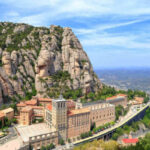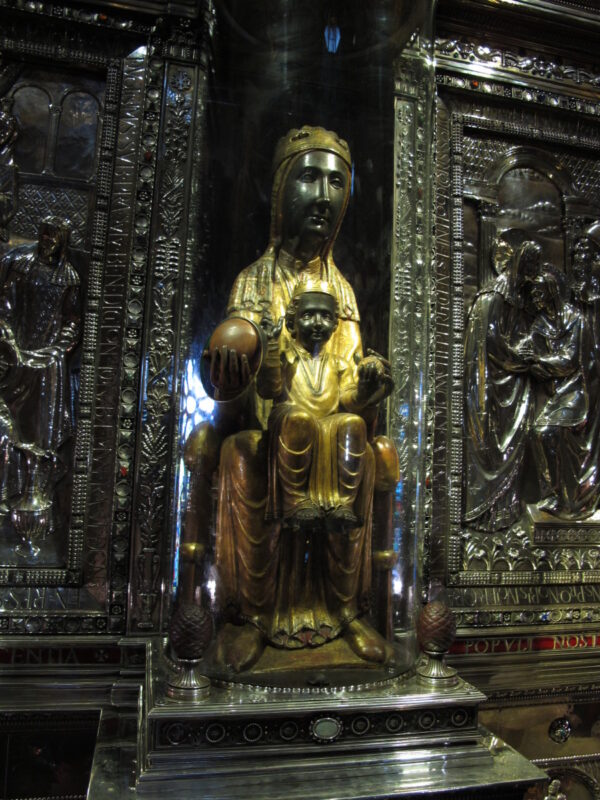
Nestled in the rugged mountains of Catalonia, the Black Madonna of Montserrat has captivated pilgrims and visitors for centuries. This enigmatic figure, known for its striking dark complexion, is not only a religious icon but also a symbol of mystery and devotion, drawing countless seekers searching for enlightenment and solace.
In this exploration titled The Mysterious Black Madonna at Montserrat: Unveiling its Secrets, we will delve into the origins, significance, and legends surrounding this revered statue. From its historical roots to the rituals that surround it, the Black Madonna of Montserrat continues to inspire awe and curiosity, inviting us to uncover the secrets that lie within its shadowy presence.
The History and Origins of the Black Madonna at Montserrat
The origins of the Black Madonna at Montserrat are steeped in legend and tradition, with its beginnings tracing back to the 9th century. According to historical accounts, the statue was discovered by shepherds in a cave, where they heard a heavenly voice guiding them to this sacred site. Over time, the statue became a focal point for pilgrimages, symbolizing hope and divine protection for the people of Catalonia.
Throughout history, the Black Madonna has been attributed various stories and interpretations, each adding layers to its significance. Some believe it represents a fusion of Christian and pre-Christian beliefs, illustrating the cultural interplay in the region. The statue's distinctive skin tone has led to interpretations linking it to ancient goddess figures, emphasizing the universality of the maternal archetype.
In addition to its spiritual importance, the Black Madonna of Montserrat has been a significant cultural icon. The statue has inspired countless works of art and literature, and its presence has fostered a sense of community among believers. Rituals surrounding the Madonna, such as the annual pilgrimage, allow devotees to connect with their faith and heritage, further embedding the statue in the fabric of Catalan identity.
To better understand the historical context of the Black Madonna, consider the following timeline of key events related to its veneration:
| Year | Event |
|---|---|
| 880 AD | Discovery of the Black Madonna in the Montserrat cave |
| 12th Century | Construction of the first monastery dedicated to the Black Madonna |
| 19th Century | Restoration and increased popularity among pilgrims |
| 20th Century | Black Madonna becomes a symbol of Catalonia's resilience |
Secrets Behind the Black Madonna's Iconic Symbolism
The Black Madonna of Montserrat is rich in symbolic meaning, reflecting a deep connection to both spirituality and cultural identity. Her dark complexion is often interpreted as a representation of the divine feminine, embodying strength, resilience, and nurturing qualities. This unique aspect serves to bridge various cultural beliefs, resonating with those who seek comfort and empowerment through her image.
One of the most intriguing secrets behind the Black Madonna's symbolism lies in her association with earthly elements. Many interpretations suggest that her color signifies a link to the earth and nature, highlighting the importance of maternal figures in both mythology and religion. This connection encourages devotees to honor not just the spiritual realm but also their roots and environment.
Additionally, the rituals surrounding the Black Madonna enhance her iconic status. Pilgrims often engage in specific practices that symbolize personal transformation and healing. Some key rituals include:
- Lighting candles as an offering to signify hope and prayer.
- Whispering secrets to the statue, believed to be heard by the Madonna.
- Participating in communal prayers to strengthen community bonds.
Ultimately, the Black Madonna's enduring appeal lies in her multifaceted symbolism, which invites individuals to explore their own identities while connecting with a larger narrative of faith and devotion. Her presence continues to inspire a sense of belonging and purpose, making the journey to Montserrat a profound experience for many.
Exploring the Spiritual Significance of the Montserrat Black Madonna
Exploring the spiritual significance of the Montserrat Black Madonna reveals layers of meaning that resonate deeply with pilgrims and visitors alike. Many view her as a source of divine femininity, embodying qualities such as nurturing, strength, and resilience. This connection to the divine feminine allows individuals to find solace and empowerment in their personal journeys, fostering a sense of belonging within a larger spiritual narrative.
The rituals associated with the Black Madonna further enhance her spiritual significance, inviting devotees to engage in transformative practices. Some of these rituals include:
- Candle lighting to symbolize prayers and hopes directed towards the divine.
- Private confessions whispered to the statue, believed to facilitate personal healing.
- Communal gatherings for prayer, reinforcing community ties and shared faith.
Moreover, the Black Madonna serves as a bridge between cultures and beliefs. Her dark visage invites interpretations that link her to ancient mother goddesses, highlighting the universal need for a maternal figure across various traditions. This blending of cultural elements enriches the spiritual experience, allowing visitors to reflect on their own heritage while embracing the diverse tapestry of faith.
Ultimately, the enduring presence of the Black Madonna at Montserrat encourages a profound exploration of one's spirituality and connection to the earth. Her symbolism reminds us of the importance of community and faith, urging individuals to embark on their own journeys of discovery and transformation as they seek the guidance of this revered icon.
The Artistic Representation of the Black Madonna: A Closer Look
The artistic representation of the Black Madonna at Montserrat is not merely a visual delight but a profound embodiment of cultural and spiritual narratives. Her distinct dark complexion, crafted in wood and adorned with intricate details, often evokes interpretations of the divine feminine. The artistry is believed to reflect not only the spiritual essence but also the diverse cultural influences that have shaped her image over centuries.
One can observe a fascinating interplay of styles in the various artistic renditions of the Black Madonna. These include:
- Romanesque influences in her early depictions, showcasing simplicity and directness.
- Gothic elements in later versions, introducing more elaborate details and emotional depth.
- Modern interpretations that further explore her symbolism and relevance in contemporary spirituality.
The materials used in crafting the Black Madonna also hold significant meaning. While wood has traditionally been utilized, the choice of colors and textures often conveys messages of resilience and strength. Her dark hue, in particular, invites reflections on the interconnection of earth and spirit, emphasizing a nurturing presence that resonates across various cultures and religious traditions.
Ultimately, the artistic representation of the Black Madonna serves as a vital touchstone for believers and artists alike, inviting a deeper appreciation of her role as a symbol of hope and transformation. Each artistic interpretation adds a new layer to her story, ensuring that the Black Madonna remains a dynamic and evolving figure in the spiritual landscape.
Pilgrimage to Montserrat: The Black Madonna's Role in Faith and Tradition
The pilgrimage to Montserrat is a profound journey that intertwines faith and tradition, with the Black Madonna at its heart. For centuries, devotees have traveled to this sacred site, drawn by the statue's reputation as a powerful intercessor. Many believe that engaging with the Black Madonna can bring about personal transformation, healing, and a deeper connection to their spirituality.
The rituals associated with the pilgrimage enhance its significance, allowing participants to immerse themselves in a rich tapestry of cultural practices. Pilgrims often engage in activities such as:
- Walking the winding paths leading to the monastery, which symbolizes a journey of introspection.
- Offering prayers at the foot of the statue, believed to invite divine guidance.
- Sharing stories and experiences with fellow pilgrims, fostering a sense of community and shared faith.
Moreover, the Black Madonna serves as a symbol of hope for the Catalan people. Throughout history, she has represented resilience and unity, especially during times of struggle. Pilgrims often carry the weight of personal and collective challenges as they approach the statue, seeking solace and strength in her presence, which embodies the spirit of perseverance.
In essence, the pilgrimage to Montserrat is not simply a physical journey but a spiritual odyssey that invites individuals to reflect on their beliefs and connections to the divine. The Black Madonna stands as a beacon of faith, drawing seekers from all walks of life, each looking to unveil their own mysteries and find comfort in her enduring embrace.
Unraveling the Mysteries: The Legends Surrounding the Black Madonna
The legends surrounding the Black Madonna at Montserrat are as captivating as the statue itself, each one adding depth to her mystique. One popular tale describes how the statue was hidden in a cave by monks to protect it from invaders, only to be discovered centuries later by humble shepherds. This narrative highlights the Madonna's role as a guardian, imbuing her with a sense of protection and divine intervention that resonates with her followers.
Another intriguing legend speaks of the miraculous powers attributed to the Black Madonna. Many believers recount stories of personal transformations, healings, and answered prayers after visiting her shrine. These accounts often include:
- Miraculous sightings of light surrounding the statue.
- Spontaneous healings experienced by pilgrims.
- Visions that guide seekers toward their spiritual paths.
Additionally, the Black Madonna is often linked to ancient fertility goddesses, with some legends suggesting she embodies both the spiritual and physical aspects of motherhood. This connection offers a rich tapestry of symbolism that speaks to the universal themes of nurturing and resilience found in both religious and cultural narratives. The blending of these stories emphasizes the Madonna's significance as a figure that transcends time and tradition.
As we explore the legends surrounding the Black Madonna, it becomes clear that her story is not just one of a religious icon but also a complex narrative woven into the cultural fabric of Catalonia. Each legend invites pilgrims and visitors to reflect on their own journeys, seeking solace, guidance, and a deeper understanding of their faith and identity in the shadow of this revered figure.
 What is the Difference Between a Cable Car and a Funicular: Exploring Barcelona's Unique Modes of Transportation
What is the Difference Between a Cable Car and a Funicular: Exploring Barcelona's Unique Modes of Transportation Discovering the Equivalent of Montserrat: Unveiling Barcelona's Hidden Gem.
Discovering the Equivalent of Montserrat: Unveiling Barcelona's Hidden Gem. The Enigmatic Monastery near Barcelona: Unveiling its Fascinating Secrets
The Enigmatic Monastery near Barcelona: Unveiling its Fascinating SecretsIf you want to know other articles similar to The Mysterious Black Madonna at Montserrat: Unveiling its Secrets you can visit the category WHERE YOU CAN GO.
Leave a Reply










Read more!